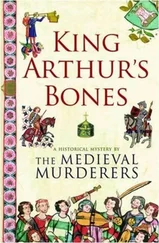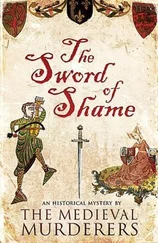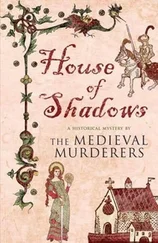The object in question was kept on the high altar, but an hour after the prior’s meeting it was being used in the chancel of the church. A dozen pilgrims and supplicants were gathered in the empty nave, having come to the priory either indifferent to, or ignorant of, the presence of a hostile army just over the horizon. Most of them had some ailment, ranging from weeping skin ulcers to severe arthritis, but a few were ordinary pilgrims, curious about the well-known cult of St Beornwyn.
Today it was the turn of Brother Louis, the infirmarian, to administer the cures. Half a dozen of the monks occupied the quire stalls on each side of the chancel, providing harmonious chanting while Louis went to the altar. With repeated genuflection, he opened the gilded doors of the reliquary and removed the most precious fragment of their beloved Beornwyn, which lay amongst other parts of her skeleton.
It was a bowl-shaped calvarium, the top of the skull of the beautiful saint, which had been embellished with a wide band of heavy gold around the circumference, into which a repetitive motif of butterflies had been engraved.
Turning, Brother Louis held the relic high above his head and, as the chanting changed, began intoning a litany of Latin prayers. The small congregation in the nave dropped to their knees on the cold flagstones and crossed themselves, murmuring their own prayers as the infirmarian advanced towards the holy well, placed beneath the chancel arch, at the foot of the steps leading up to the presbytery.
It was an ornate structure of pink marble standing head high, the base carved with cherubim and seraphim. The upper part was a large alabaster statue of St Beornwyn herself, gazing down benignly into a large marble bowl shaped like a seashell, lying at the foot of the edifice. Just above the bowl, a kneeling angel held a pitcher under his arm, from which a small cascade of water fell into the bowl, almost filling it until the excess ran off through an overflow. The water passed into a conduit under the church and reappeared at a much more mundane spring in the outer courtyard, where it was used for everyday purposes in the priory and also for bathing the feet or other afflicted parts of supplicants who desired external treatment of their diseases.
Louis stood before the fountain and, with a stately bow, bent and held the ornate skull under the jet of water until it was half full.
The first supplicant who had come for a cure moved forward and kneeled before the priest, who with a sonorous stream of Latin, blessed the limpid fluid in the skull. Then bending, Brother Louis held it to the lips of the pilgrim who took a sip, or rather a gulp, as he was determined to get his money’s worth. This was repeated for each of the supplicants who were waiting patiently in the nave, and after much genuflection and mumbling of prayers, they lined up again before the infirmarian, who gave them a general blessing and then directed them to seek further diagnosis and treatment at the infirmary, if they so wished. Though he did not say it directly, there was a tacit understanding that such additional medical care would come at a price, though, to be fair, this was graded according to their apparent means and for those who were sick but obviously near-destitute, the treatment was free.
Later, one of the supplicants took advantage of this invitation and sought out Louis in his consulting room. A rotund cloth merchant from Evesham, he was suffering from severe flatulence and pains in his belly after eating. After examining him, which included prodding his corpulent belly, Louis suspected that much of his problem was due to overweight, but produced an earthenware pot, sealed with a wooden stopper.
‘At the end of each meal, swallow as much of this as would fill half an eggshell,’ he commanded. ‘And cut down drastically on your victuals, especially fatty pork and other greasy food.’
Handing the jar to the merchant, he told him to return when it was all used, or go to an apothecary in Evesham and buy more. He handed the man a slip of parchment on which were written some cabalistic marks, as a prescription for the apothecary.
Gratefully, the clothier departed, placing a liberal pile of silver pennies on Louis’s table. Before he left, he enquired about the saint who, he hoped, would work miracles upon his belly, aided by the infirmarian’s mixture of chalk, valerian and peppermint.
‘How did this priory come to be established in such a lonely place?’ he asked.
The infirmarian was quite willing to engage in conversation with this intelligent and liberal fellow.
‘It is said that a healing well has been here since time immemorial,’ he said, sitting back in his chair. ‘Even in the time of those Ancient Britons that we read about in Geoffrey of Monmouth’s famous book, people came from far and wide to drink and wash in its waters. There are several such wells along the Malvern hills, but this one has the best reputation.’
‘But why did this one have a Benedictine house placed over it?’ persisted the inquisitive merchant.
‘Before the Normans came, a daughter of the Earl of Hereford suffered from the falling sickness, which was cured by the waters of this spring,’ replied Louis. ‘The Earl was so impressed that he granted not only twenty hides of land here, but also gave a generous endowment for the priory.’
‘But why dedicated to St Oswald and St Beornwyn?’ asked the merchant.
‘The earl was influenced by his confessor, a Benedictine monk, who came from the Shire of York and was devoted to the memory of St Oswald, so the priory is named after him. Oswald was King of Northumbria in ancient times and, although a ferocious soldier, became a saint after his death in battle at Oswestry, because he had converted the pagan Northumbrians to the way of Christ.’
The clothier’s forehead wrinkled in puzzlement. ‘So why is the church dedicated to this St Beornwyn? Who was she?’
Brother Louis, ever an impatient man, was beginning to get a irritated by the merchant’s persistence, thinking that he was demanding a lot for his silver pennies. However, he decided to humour him one last time.
‘Several hundred years after Oswald’s death, which was a violent dismemberment, the same thing happened to a devout virgin in a church dedicated to St Oswald near Whitby. She was horribly mutilated by Viking berserkers on one of their raids upon the Northumbrian coast, and for her virtue and martyrdom she was herself elevated to sainthood. Some two hundred years ago, some of her bones were given to this church as holy relics.’
Satisfied at last, the clothier ambled away clutching his pot of stomach medicine and with a sigh of relief, the infirmarian rose and went into the ward where Brother John was sitting up on his pallet. After a perfunctory examination, Louis stood back and told the old monk that there was no reason why he should not rejoin his fellow monks.
‘You can eat in the frater and sleep in the dorter as usual,’ he declared. ‘Tomorrow you can go back to your duties in the scriptorium. Doing your usual tasks will keep your mind off your strange delusions.’
Brother John had become too feeble and unreliable to continue his old duties about the farm or dealing with the pilgrims, so the prior had relegated him to the scriptorium, a small chamber above the chapter house. This housed the priory’s small library and was where any work on manuscripts was carried out, directed by the sacristan. John had been given the task of making copies of psalms and chants for the choir and any other calligraphic work that was needed.
After supper, in the mild light of the summer evening, most of the monks congregated for a social hour in the ‘warming room’ situated at the end of the refectory. The fireplace was now empty, but in the cold weather it contained the only fire in the monks’ accommodation, apart from that in the prior’s parlour.
Читать дальше












